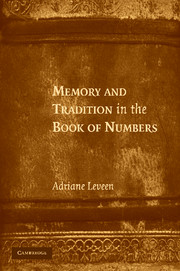Book contents
- Frontmatter
- Contents
- Acknowledgments
- ONE Desert Bound
- TWO Weaving by Design
- THREE Priestly Purposes
- FOUR Variations on a Theme: Shaping Memory in the Wilderness
- FIVE Crisis and Commemoration: The Use of Ritual Objects
- SIX Falling in the Wilderness: The Politics of Death and Burial
- SEVEN Inheriting the Land
- APPENDIX A The Priestly Sphere of Activity in the Book of Numbers
- APPENDIX B The Use and Variation of God's Address to Moses and to Aaron
- APPENDIX C Death Reports
- APPENDIX D Proper and Improper Treatment of the Dead
- Notes
- Bibliography
- Index
- Scriptural Index
- Selected Hebrew Index
SIX - Falling in the Wilderness: The Politics of Death and Burial
Published online by Cambridge University Press: 21 July 2009
- Frontmatter
- Contents
- Acknowledgments
- ONE Desert Bound
- TWO Weaving by Design
- THREE Priestly Purposes
- FOUR Variations on a Theme: Shaping Memory in the Wilderness
- FIVE Crisis and Commemoration: The Use of Ritual Objects
- SIX Falling in the Wilderness: The Politics of Death and Burial
- SEVEN Inheriting the Land
- APPENDIX A The Priestly Sphere of Activity in the Book of Numbers
- APPENDIX B The Use and Variation of God's Address to Moses and to Aaron
- APPENDIX C Death Reports
- APPENDIX D Proper and Improper Treatment of the Dead
- Notes
- Bibliography
- Index
- Scriptural Index
- Selected Hebrew Index
Summary
… collective memory serves as an excellent instrument of power.
Mortal remains are never a matter of indifference where bonds of love and kinship exist.
In his mythic poem רבדמ יתמ, the modern Hebrew poet Hayyim Nahman Bialik imagines the entire biblical generation that has been liberated from Egypt lying exposed in the wilderness. In the opening stanza, they are first spotted sprawled across the ground:
Their faces are tough and tanned, …
Their foreheads are stubborn and bold, defying the wrath of the heavens.
Bialik vacillates between depicting them as dead or merely at rest:
… the mighty phalanx awakes.
They suddenly rouse themselves, the stalwart men of war,
lightening ablaze in their eyes, their faces aflame, hands on swords.
Whether dead or merely sleeping, the wilderness encompasses them in anonymity, shielding them from the outside observer:
No one on earth knows the site, nor knows of their rise, or their fall.
Heaps of hills piled up by the storm enclose and encircle them.
In an epigraph to his poem Bialik alludes to a talmudic legend that pictures this same generation alive and at rest. In the legend, an Arab merchant leads Rabbah b. Bar Hana through the desert to find the generation. Rabbah b. Bar Hana describes what he saw: “They looked as if in a state of exhilaration. They slept on their backs: the knee of one of them was raised.”
Why do both poet and rabbinic legend render the wilderness generation merely at rest rather than dead?
- Type
- Chapter
- Information
- Memory and Tradition in the Book of Numbers , pp. 140 - 165Publisher: Cambridge University PressPrint publication year: 2007



